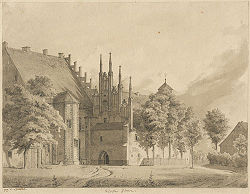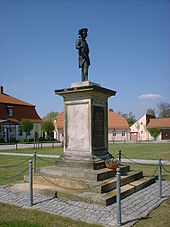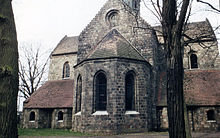Zinna Monastery
| Zinna Cistercian Abbey | |
|---|---|
 Zinna Monastery in the 19th century |
|
| location |
Brandenburg District Teltow-Fläming |
| Coordinates: | 52 ° 1 '21 " N , 13 ° 6' 14" E |
| Serial number according to Janauschek |
418 |
| founding year | 1170 |
| Year of dissolution / annulment |
1553 |
| Mother monastery | Altenberg Monastery |
| Primary Abbey | Morimond Monastery |
Kloster Zinna ( Latin Coena S. Mariae ) is a former Cistercian - Abbey in the village Kloster Zinna the city Jüterbog in Brandenburg Teltow-Fläming , around 60 kilometers south of Berlin at the federal road 101 .
history
Cistercians
Foundation and first decades
The monastery was founded in 1170 by Wichmann von Seeburg , Archbishop of Magdeburg (1152–1192). The political background to the founding of the monastery was evidently the archbishop's intention to put a stop to the southern expansion of the neighboring Ascanian rule. The first monks came from the Altenberg monastery near Cologne . No further information has been obtained from the early days of the monastery. The construction of the monastery in the Nuthe wetlands probably began.
In 1179 the monastery was attacked by the troops of Duke Heinrich the Lion of Saxony. The monks went to Jüterbog to beg, which in itself was not common for Cistercians. Not until around 1215 are indications of a renewed use of the monastery. During this time the abbey church was probably built from granite blocks. The consecration took place on May 15, 1226.
The monastery evidently did not develop as desired at first: in 1229 it appeared on the agenda of the General Chapter of the Cistercian Order . The father abbot from Altenberg Abbey was commissioned to conduct a visitation . It should aim to find an alternative location for the monastery on the Barnim . However, this plan was not implemented.
Economic development
After the abandonment of this plan, the monastery gained economic importance for the region. In 1285, the monastery bought the town of Luckenwalde and eleven surrounding villages. At the height of its economic boom in 1307, the extent of the monastery property was almost 300 km². At the end of the 15th century the abbey owned 39 villages, 14 mills, a salt well with four salt pans , a pitch hut and a brick factory.
For the extensive trading activity , Stadthöfe u. a. entertained in Berlin, Wittenberg and Jüterbog . Even in the southeastern part of Barnim the monastery owned extensive lands. The Barnim was otherwise under the influence of the Ascanians and their home monastery Lehnin . It is noteworthy in this context that the Lehnin abbot Siger appeared as a witness in Spandau in 1247 when the Ascanian margraves, Johann I and Otto III, ruled together . have transferred the possessions around the town of Liebenberg to the Zinna Abbey. Rüdersdorf near Berlin had already been founded by Zinna around 1235 and was of particular interest to the Cistercians because of the Rüdersdorf limestone quarry , in which the monks drove the quarrying of limestone ( Museum Park Rüdersdorf ). The Barnim property extended in the east to the Stobber - Löcknitz -lauf, which formed the border to the area of influence of the Lebus diocese . Almost the entire land of today's municipality of Grünheide as far as Kienbaum with the surrounding fish-rich waters Werlsee , Peetzsee , Möllensee , Elsensee , Baberowsee , Bauernsee and Liebenberger See belonged to the property . From a farm in Kagel , the monastery initially administered its property in Barnim and then moved the administration to Rüdersdorf in the 15th century.
With their large-scale water management and hydraulic engineering measures, which included the construction of numerous water mills on the rivers and lake drains, the Cistercian monks contributed significantly to the development and settlement of the Mark.
Their trading activities , which were carried out through numerous town courts, were of particular importance . The Zinna monastery was so wealthy that it became the margraves' greatest lender. The Barnim possessions remained with Zinna until the secularization .
resolution
After a long process of decay, the Cistercian monastic life in the Zinna Monastery ended in 1553. As a result of the Reformation , the Catholic Cistercian monks were unable to assert themselves.
Zinnaer Marienpsalter
The Marienpsalter Nouum beate marie vigi [ni] s psalterium from the Zinna monastery printing house is considered to be the oldest letterpress in Brandenburg. The cradle print by the printer Hermannus Nitzschewitz from around 1493 is the most important item among the historical book holdings in the Brandenburgica Collection in the Potsdam City and State Library .
Zinna coin agreement
In 1667, the Zinna Mint Agreement was concluded in the Zinna Monastery , in which Kurbrandenburg and Electoral Saxony decided to standardize the thalers minted by them.
Frederick the Great, Weber and Summer Music

In 1764, Frederick the Great initiated the founding of a town on the monastery area, which has been called Kloster Zinna since 1902 and continues to bear it as a district of Jüterbog. Frederick the Great settled weavers from Upper Lusatia in order to revitalize the region economically. Although this did not succeed to the desired extent, the city of Friedrich erected a monument on the market square in gratitude . According to the inscription on the back, it was destroyed in 1949, but renovated on April 8, 1994 through donations from residents and guests of the village and the statue of M. Starke and F. Woike donated. The front bears the inscription:
| Frederick the Great, founder of the city in 1764, the thankful Zinna Monastery in 1864 |
In addition to the monastery complex and the surrounding landscape, the Zinna monastery invite summer music to visit. They take place annually between June and the beginning of September. There are special concerts in April and on New Year's Eve, such as a traditional candlelight concert in the “naturally tempered” church. The Musica Mediaevalis medieval series is also offered together with the Lehnin Monastery . The Brandenburg Summer Concerts also regularly stop at Marienkirche.
Parts received
In addition to the abbey church, new abbey , infirmary and customs house , some parts of the cloister from the 13th century and the guest house have been preserved from the originally extensive monastery . Only a pilgrimage cross on the top of the mountain reminds of the former pilgrimage site of the monastery on the nearby Golmberg .
Monastery church
The simple monastery church built from field stones is a late Romanesque pillar basilica with a cross-shaped floor plan. It is dedicated to the Virgin Mary . A polygonal main apse is attached to the east choir and four polygonal secondary apses to the transept. During the late Gothic period , arches were drawn in in the side aisles, side choirs and in the transept .
The Latin writing field on the choir floor dates from the 13th and 14th centuries. The letters of the in Gothic capital letters drafted Ave Maria appear in high relief impression on unglazed, red-brown clay tiles. Such single-letter tiles can be seen as an early form of printing with movable type .
A musical stroke of luck is the early romantic organ by Wilhelm Baer from 1850/1851; During visits there is a walk through the organ.
In 2016 and 2017, the church was extensively renovated for around one million euros .
New abbey, infirmary, customs house
In the New Abbey, a brick building, is the local history museum with medieval frescoes and a model of the monastery complex from 1170 that is well worth seeing. Furthermore, the history of the monastery up to around 1550 and the development of the weavers' colony are presented. In the former infirmary, the herbal liqueur Zinnaer Klosterbruder is still made according to old recipes. In the old factory of the weaving colony on the outskirts towards Jüterbog you can see the traditional weaving technique and watch hand weavers at work.
literature
Overall representations
- Heinrich Berghaus : Land book of the Mark Brandenburg and the Markgrafthums Nieder-Lausitz , Volume 1, Brandenburg 1854, pp. 510-523 ( books.google.de ).
- Evangelical Rectory Monastery Zinna (Ed.): Monastery Zinna , Heimatspiegel Verlagshaus Meinecke, Nordstedt no year, p. 18.
- Willy Hoppe: Zinna Monastery. A contribution to the history of the East German colonial country and the Cistercian order. Munich / Leipzig 1914.
- Oliver H. Schmidt: Monastery Zinna and the order of the Cistercians . Lukas Verlag, Berlin 2001. ISBN 3-931836-10-X .
- Oliver H. Schmidt: Brandenburg monastery book. Volume II . In: Heinz-Dieter Heimann , Klaus Neitmann , Winfried Schich and others (eds.): Brandenburgisches Klosterbuch. Handbook of the monasteries, pens and commander by the mid-16th century . 2 volumes, Be.Bra Wissenschaft Verlag, Berlin 2007, ISBN 978-3-937233-26-0 , Zinna. Cistercians, pp. 1359-1384.
Partial aspects
- Wolfgang Ribbe : On the religious policy of the Ascanians. Cistercians and sovereignty in the Elbe-Oder region. In: Cistercian Studies I (= Studies on European History 11). Colloquium-Verlag, Berlin 1975. ISBN 3-7678-0379-8 . Pp. 77-96.
- Oliver H. Schmidt, Dirk Schumann (Ed.): Cistercians in Brandenburg . (= Studies on the history, art and culture of the Cistercians . Volume 1). Lukas Verlag, Berlin 1996, ISBN 3-931836-01-0 (5 of the 9 articles exclusive to the Zinna Monastery).
- Winfried Schich : Monasteries and cities as new central places of the high Middle Ages in the area east of the middle Elbe . In: Karl-Heinz Spieß (Hrsg.): Landscapes in the Middle Ages . Franz Steiner Verlag, Stuttgart 2006. ISBN 978-3-515-08579-3 . Pp. 113-134.
architecture
- Ernst Badstübner : Monastery architecture and sovereignty. For the interpretation of the architectural form of Brandenburg monastery churches. In: Friedrich Möbius, Ernst Schubert (Ed.): Architecture of the Middle Ages. Function and shape . 2nd, reviewed edition, Böhlau, Weimar 1984, pp. 184-239.
- Christian Klamt: Letters from baksteen in a cistercian monastery. Het Ave Maria te Zinna . In: René Ernst Victor Stuip (Ed.): Meer dan muziek alleen. In memoriam Kees Vellekoop (= Utrechtse bijdragen tot de mediëvistiek, vol. 20). Uitgeverij Verloren, Hilversum 2004. ISBN 90-6550-776-0 , pp. 195-210.
Web links
- Entry in the monument database of the State of Brandenburg
- Zinna Jüterbog Monastery - official website
- Zinna Monastery Summer Music
- Zinna Monastery
- Romanesque routes in Berlin and Brandenburg - Zinna Monastery
Individual evidence
- ↑ Roland Fröhlich: The Cistercians and their vineyards in Brandenburg (= studies on the history, art and culture of the Cistercians , vol. 30). Lukas Verlag, Berlin 2010. ISBN 978-3-86732-070-2 . P. 186.
- ^ Stephan Warnatsch: History of the Lehnin Monastery 1180–1542. Studies on the history, art and culture of the Cistercians. Vol. 12.1. Freie Universität Berlin, dissertation 1999. Lukas, Berlin 2000, pp. 337, 399 ISBN 3-931836-45-2
- ^ Stephan Warnatsch: History of the Lehnin Monastery 1180–1542. Register directory. Vol. 12.2., Entry No. 91 ISBN 3-931836-46-0
- ^ Eva Driescher: Settlement history and anthropogenic changes in the waters in the catchment area of the Löcknitz. ( Memento from May 8, 2014 in the Internet Archive ) (PDF; 4.5 MB) In: Gewässerökologie Norddeutschlands. Issue 3, 1996.
- ^ German Water History Society e. V., Communications No. 15, September 2010, p. 38f (PDF; 9.9 MB)
- ↑ Klamt (2004), pp. 195-210.
- ↑ Brekle, Herbert E. (1997): The typographical principle. An attempt to clarify the terms , in: Gutenberg-Jahrbuch , Vol. 72, pp. 58–63 (61f.) ( PDF )
- ↑ The church in Zinna Monastery is consecrated again . In: Berliner Zeitung , June 13, 2017, p. 14.


